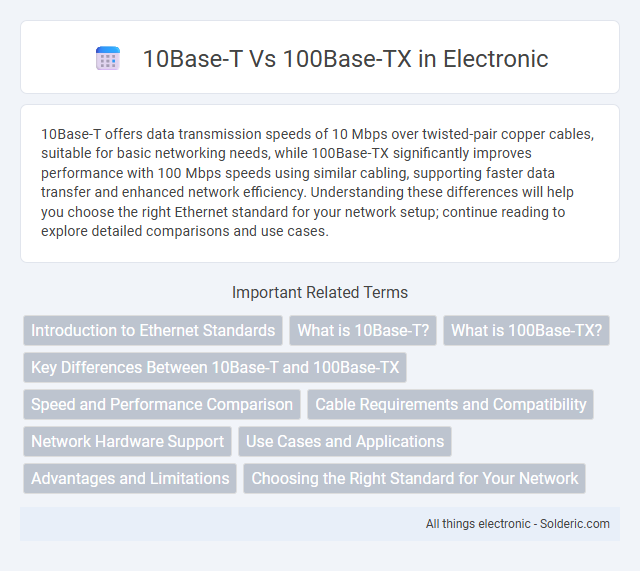10Base-T offers data transmission speeds of 10 Mbps over twisted-pair copper cables, suitable for basic networking needs, while 100Base-TX significantly improves performance with 100 Mbps speeds using similar cabling, supporting faster data transfer and enhanced network efficiency. Understanding these differences will help you choose the right Ethernet standard for your network setup; continue reading to explore detailed comparisons and use cases.
Comparison Table
| Feature | 10Base-T | 100Base-TX |
|---|---|---|
| Speed | 10 Mbps | 100 Mbps |
| Medium | Twisted Pair (Cat3 or higher) | Twisted Pair (Cat5 or higher) |
| Cabling | UTP, 2 pairs | UTP, 2 pairs |
| Maximum Segment Length | 100 meters | 100 meters |
| Duplex Mode | Half and Full Duplex | Full Duplex |
| Encoding Method | Manchester Encoding | 4B5B Encoding with MLT-3 |
| Standard | IEEE 802.3i | IEEE 802.3u |
| Typical Use | Legacy Ethernet networks | Fast Ethernet networks |
Introduction to Ethernet Standards
10Base-T and 100Base-TX are foundational Ethernet standards that define the speed and cabling for local area networks. 10Base-T supports transmission speeds up to 10 Mbps using twisted-pair copper cables, while 100Base-TX offers a tenfold increase to 100 Mbps with similar cabling but improved signaling and reduced interference. Understanding these standards helps you choose the appropriate network infrastructure for reliable data communication and scalability.
What is 10Base-T?
10Base-T is an Ethernet standard that transmits data at 10 Mbps over twisted pair copper cabling, specifically Category 3 or better. It supports a maximum segment length of 100 meters and uses baseband signaling with a star topology. Designed for early LANs, 10Base-T is largely superseded by faster standards like 100Base-TX but remains a foundational technology in networking history.
What is 100Base-TX?
100Base-TX is an Ethernet standard that supports data transmission rates of up to 100 Mbps over twisted-pair copper cabling, specifically using two pairs of Category 5 or higher cables. It operates on the Fast Ethernet protocol, offering a significant speed improvement compared to the 10 Mbps transmission of 10Base-T. The 100Base-TX standard uses full-duplex communication and supports auto-negotiation for optimal speed and duplex settings between connected devices.
Key Differences Between 10Base-T and 100Base-TX
10Base-T transmits data at 10 Mbps using two twisted pairs of Category 3 or higher cabling, while 100Base-TX supports 100 Mbps speeds and requires Category 5 or better cables. The key differences include data rate, cable quality, and signaling technology, with 100Base-TX utilizing more advanced encoding schemes for faster and more reliable transmission. Understanding these distinctions helps you select the appropriate Ethernet standard for your network's performance needs.
Speed and Performance Comparison
10Base-T supports data transmission speeds up to 10 Mbps, making it suitable for basic networking tasks with limited bandwidth requirements. In contrast, 100Base-TX delivers speeds of 100 Mbps, offering ten times the throughput and significantly enhanced performance for data-intensive applications and multimedia streaming. The improved speed and reduced latency of 100Base-TX enable better network efficiency and smoother communication in modern Ethernet environments.
Cable Requirements and Compatibility
10Base-T uses Category 3 twisted-pair cabling with a maximum length of 100 meters, making it compatible with older network infrastructures. In contrast, 100Base-TX requires higher-quality Category 5 or better twisted-pair cables to support data transmission speeds up to 100 Mbps over the same maximum cable length. Both standards maintain RJ-45 connectors, ensuring physical compatibility, but 100Base-TX demands stricter cable specifications to reduce interference and maintain signal integrity.
Network Hardware Support
10Base-T supports older network hardware compatible with 10 Mbps Ethernet, commonly using Category 3 or higher twisted pair cables, while 100Base-TX requires more advanced hardware designed for 100 Mbps speeds and utilizes Category 5 or better cables. Network devices such as switches and network interface cards (NICs) must support Fast Ethernet standards to handle 100Base-TX, ensuring enhanced data transfer rates and reduced latency. Legacy 10Base-T hardware often lacks the capabilities for full-duplex communication and higher bandwidth, limiting network performance compared to 100Base-TX equipment.
Use Cases and Applications
10Base-T is commonly used in small office networks or older infrastructure where data transfer demands are low, supporting speeds up to 10 Mbps over twisted-pair copper cables. 100Base-TX offers faster speeds of up to 100 Mbps, making it suitable for modern office environments, multimedia streaming, and larger enterprise networks requiring higher bandwidth. Your network performance improves significantly when upgrading from 10Base-T to 100Base-TX, especially in applications demanding faster data transmission and reduced latency.
Advantages and Limitations
10Base-T offers compatibility with older networking equipment and lower costs, making it suitable for simple, low-traffic networks. However, its maximum speed of 10 Mbps limits performance in modern data-heavy environments. On the other hand, 100Base-TX provides a tenfold speed increase to 100 Mbps, improving data transfer rates and supporting more demanding applications, but requires higher quality cabling and is less compatible with outdated devices.
Choosing the Right Standard for Your Network
Choosing the right network standard depends on your speed requirements and infrastructure compatibility. 10Base-T supports speeds up to 10 Mbps and is suitable for simple, low-traffic environments, while 100Base-TX delivers 100 Mbps, ideal for faster data transfer and modern applications. Network devices and cabling must support the selected standard to ensure optimal performance and future scalability.
10Base-T vs 100Base-TX Infographic

 solderic.com
solderic.com